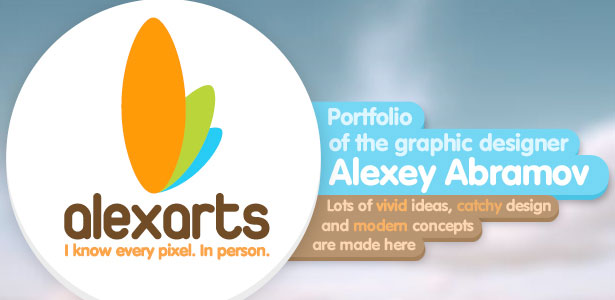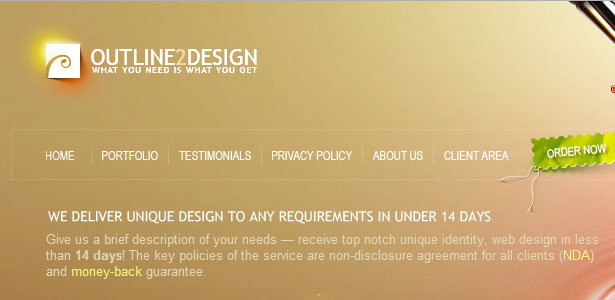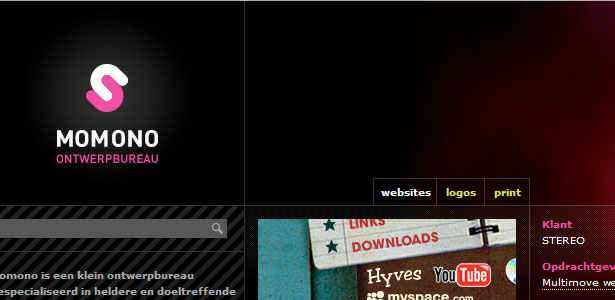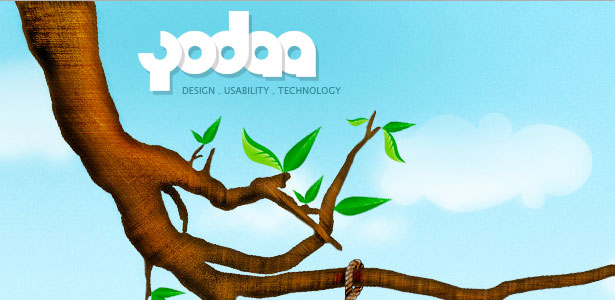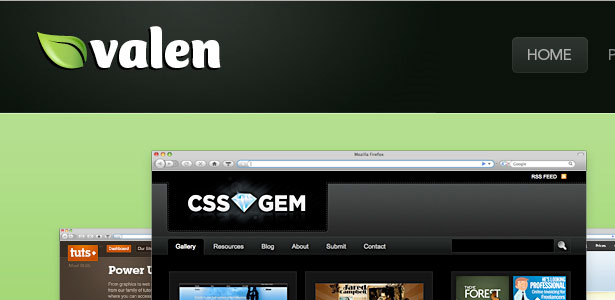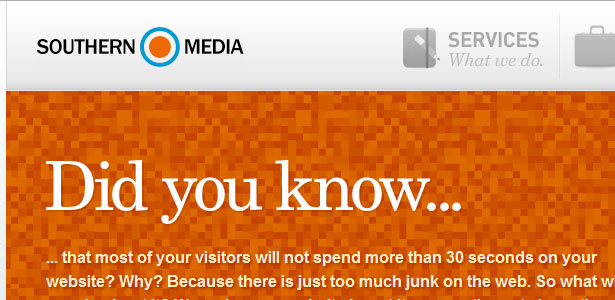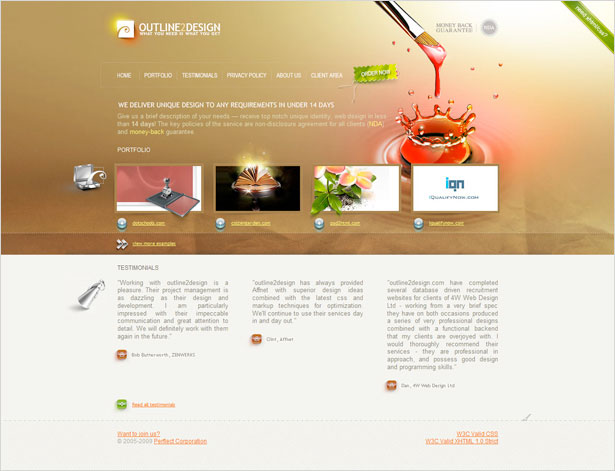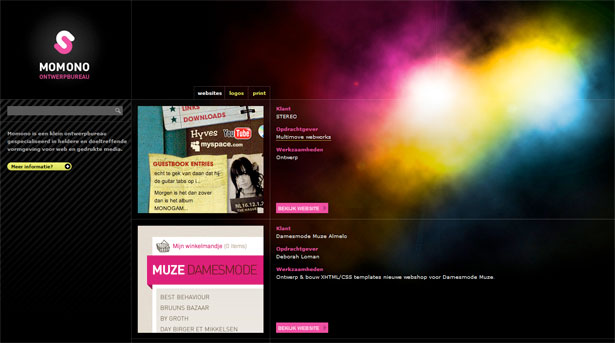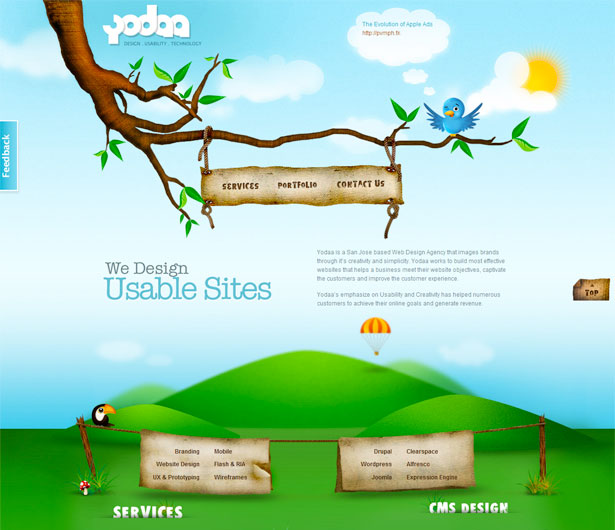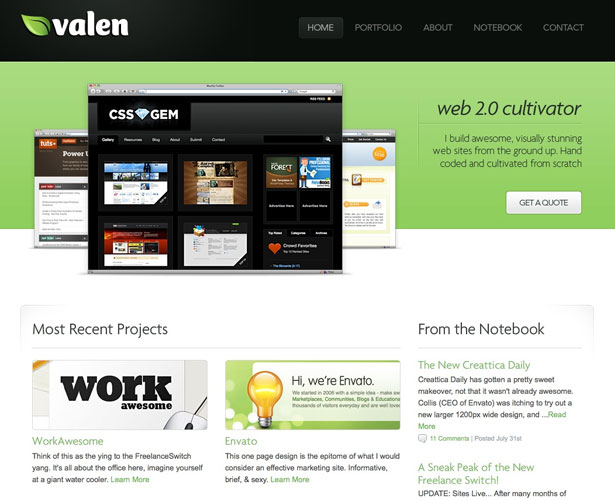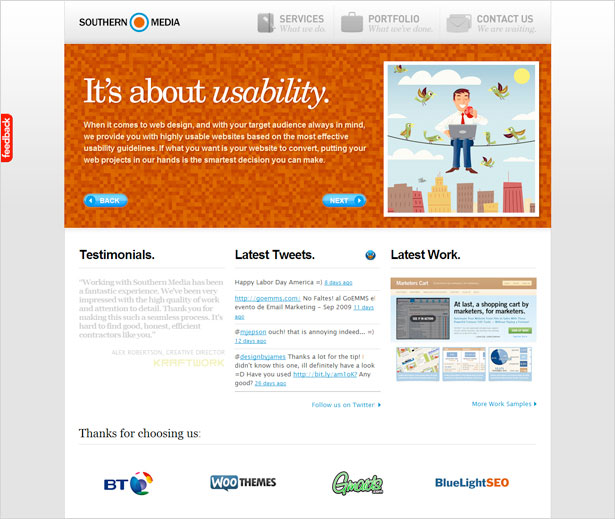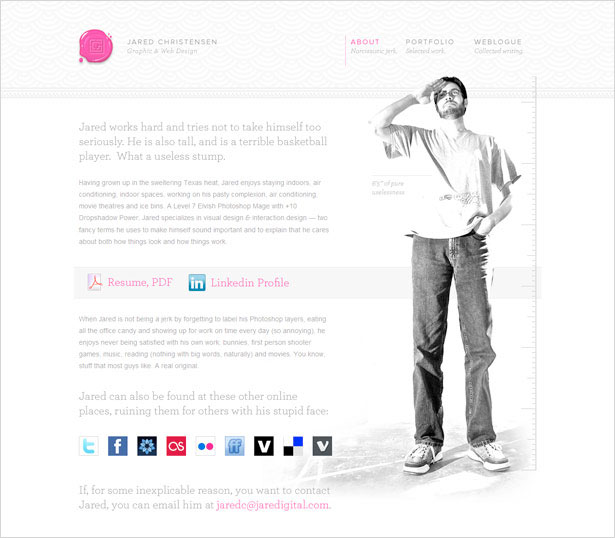 Just as it is for big corporations, successful branding is essential to the success of a freelancing business and to just one self-employed web worker.
Just as it is for big corporations, successful branding is essential to the success of a freelancing business and to just one self-employed web worker.
It is often times overlooked, most likely because many don't realize the large benefits that can come from it.
The first thing we think of when we think "brand identity" is a good logo.
A good logo can do wonders for a self-employed freelancer, but branding identity goes far beyond that, into entire website development, content, business cards, and even into offline scenarios.
In this article, we'll take a closer look at ways to define a brand for something as unique as a freelancing business, and what one needs to do to get started on the right track to a successful brand.Before we get into the specifics, let's take a look at how a brand can help any sort of business.
A good brand will lead to success now and in the future, and that is essential for a self-employed person that doesn't ever want to be forced back into a 9-5 job. If created correctly, a good brand will:
- Create a memorable business
This will make the clients want to come back to, creating user loyalty. - Create a basis for the business to expand in new ways
When launching a new project, a brand can be used to jump-start it successfully. - A good brand confirms credibility
This is top concern among many potential clients. - A properly implemented brand will target the right clients
This will help finding the right clients looking for exactly your style.
1. Define Your Business Goals
Before one even gets started in the design process of branding, one must define what they want the brand to communicate.
In order to do that, we must define a few specific things in general, the first being the freelancing business's goals.
Beyond helping to develop a brand, defining business goals will help in a number of other ways.
For one, it will help visualize the ultimate goals of the business, helping smaller goals become more proactive in reaching the long-term accomplishments.
It will also keep you, as the leader of the business, on track, from personal self-management, to anyone you may be managing in the future.
Getting off track is why many businesses fail, and why many freelancers eventually go back to a day job they hate. Goals and a business plan will help you to stay on track.

Take some time aside to set goals properly. Write them down, detail them, and think about them critically. Goals can help plan the future of a freelancing career for years to come. Below are ten items to keep in mind when setting goals:
- Be specific
Losing sight of where you're going is an issue that comes from having no goals, but having unspecific goals will also create this problem. - Create a business plan
This should be a separate article in itself, but it is a great way to outline goals as well as include finances and tools into accomplishing those goals. - Set short-term goals along with your long-term goals
It's easy to turn ultimate dreams into business goals, as we should, but shorter, more technical goals can track success better. - Keep committed
This is an obvious point, but think of lifestyle changes that will help you commit to the goals that are made. For example, if you would like to expand your skill set, set aside a time each day in your schedule to study. - It may help to make goals public
Make your freelancing business and goals associated with it as public as possible. If this means sharing with only friends and family, then so be it. It will help to motivate you to complete goals — keeping your business on track. - Be realistic
It's ok to dream high, but don't set unachievable goals for a time given. - Have relevant goals
If a goal ends up providing little or nothing to the growth of the business, then it is pointless. For example, don't set a goal to take on another client each week that you can't handle — this will likely only limit the time you have to grow and market the business in other ways. A relevant goal would be, for example, to expand to more than a 1-man (or 1-woman) operation. - Create an action plan for each goal
"I'd like to someday own my own design firm", is just not good enough. Have a goal-by-goal plan to complete broader goals like this. In other words, make the goal actionable. - Keep everything in line when working on a new goal.
Reaching goals means business and lifestyle changes, so make sure your finances and other forms of security are still tightly in place throughout the process. - Take a step back to analyze the progress
Take what you've learned onto the next goal. As an example, if you're trying to market your portfolio better, what marketing strategies worked? Which strategies didn't work?
2. Define Your Target Audience
After defining business and career goals, you need to define who you'll need to attract to keep the business alive.
These people are, of course, the clients. Who is your ideal client? Beyond clients, are you willing to work with others on group projects (i.e. developer and designer)? Who would that ideal partner be?
Target audiences are often more related to one that sells products, or to a blog or other form of website that relies heavily on its visitor count. However, selling services is no different. One must recognize this and take the necessary steps to define their target audience.
Both how a brand is designed visually and how it is presented professionally will lean towards a certain type of person.
This person should be someone you'd like to work with, as well as the type of person that will help your brand grow.

When seemingly ready to open up Illustrator and start on a logo design, wait one more second and get prepared for the visual aspect of the brand-to-be.
Below are some questions to ask about the target audience before jumping into the design phase of your brand.
What is your design style?
If it is more creative, you may want to appeal to groups that would need a creative website.
If it is more Web 2.0 and sleek, you're going to want to appeal to business owners or vendors of "high-technology fields."
Consulting agencies, app websites, and other sites of the like would be great targets.
To What Level Are you Willing to Help and Communicate?
It's true; all clients have varying levels of understanding web technologies, and well, technology in general.
Do you want to attract a client that knows nothing of the web world, in which you will be responsible for providing an easy to maintain website? Or, would you rather communicate with a group of web professionals, sending out the final project to one client?
This can dig deeper into clients as well. Attracting a client, for example that is maintaining a site dedicated to some sort of technology may be easier to communicate with about technology if you prefer that.
Any other type of website that coincides with the "offline world" though may hold a client that would need a simpler website.
What work would you like to be responsible for?
Many of us don't like all the work that comes from freelancing. Especially in the world of website creation, many clients want us to do it all — design, develop, market, and more.
If you specialize in one area though, it may be beneficial to have part of your target audience be those looking for partnership projects.
For example, if you are a designer, you may want to include web developers in your target audience so that they could contact you to partner up on a bigger project.
This way, whether you know how to or not, you wouldn't be stuck with the coding and you can stick with what you love.
Define it on Paper
After asking these questions and researching a bit more, write out your target audience in a list.
Each item should not be a single-line type of person, like "Clients with a lot of web experience", but rather a small very descriptive paragraph.
The more detailed the description, the more success you'll have once it's time to start the design process of the brand.
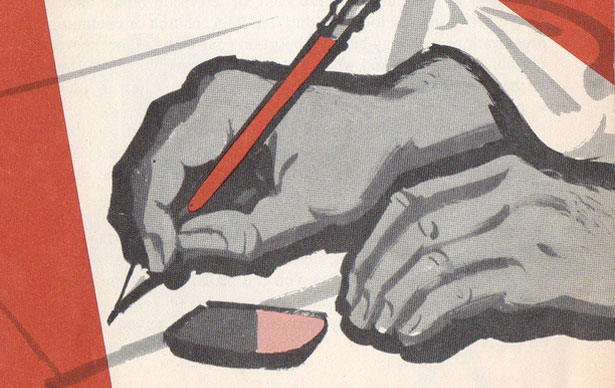
Further Resources
- Web Design, Ad Copy and Targeting your Target Audience
- Website Design - Identify Your Target Audience
- How to Market Your Small Business: Meet Customers Where They Are
3. The Business Name
Is it your own name, or a more formal and creative name?
This is often times a step overlooked, but it is incredibly relevant to the final goals of the website. If you plan to be the owner of a firm someday, or develop a team of web professionals in any other way, your given name as a brand may not be appropriate.
However, many freelancers chose to grow their business by always freelancing solo, while still outsourcing some of their work. There is a difference in each situation, and a personal name would thrive on this type of business.
Also, bigger names may attract bigger projects, while a personal name would attract many smaller clients. Depending on what you'd like to do in terms of work greatly depends on the brand's name.
So, in the plainest sense: an alternative name would be more versatile, but your own name as a brand would be more personable and each would lead to a different type of client.

Image credit: Mark McGall, 72 Thinking
4. The Logo
The logo is the first step into the design process of the brand. It is the one graphic that your business will survive upon.
Your website, content, and all other design elements must compliment a brand's logo, as well as work with it towards the ultimate goal of making the sale to the client.
Whether designing it yourself or hiring someone else to do it for you — you'll need to be the one that decides how it will look.
Many times I get clients that let me have too much creative control when it comes to their brand design. While creative control is always appreciated, when it comes to a brand — that's a bad choice.
Be sure to research and create a plan for the brand of your freelancing business so you can take control.

Everything mentioned so far in this article will come into play for the initial design phase of the brand.
The name is an obvious factor, but the target audience and business's goals will also come into play. Keep a few questions in mind concerning all of this when beginning the logo design phase:
- What does the overall style of the logo need to be to attract the right audience?
- What type of colors should be used? As different types of colors provoke different emotions, this ties in greatly to the target audience.
- How versatile does it need to be? How will it grow with your freelancing as a business?
- Does it need to be formatted well with print material as well as web material?
- What shape does it need to be, generally (more rounded/square, or rectangular)? This has a lot to do with what materials you'll be using it on and the format it will need to take when combined with content.
Some Examples
The above logo says "professional, fun, and personable". Notice how the varying colors in the web design turn into a more playful approach, which in turn makes it more personable.
The smooth curves in both the font and the image portion of the logo also take the strict factor away, making him as a business person approachable.
This freelancer runs as a single freelancer, branding his business as him — most likely returning to him one-on-one clients with great communication and many smaller, more creative projects.
This brand is a group of designers working together under one website. The brand has a more generalized name, and even a more professional, company-like feel.
Furthermore, looking more into their portfolio, one can see that the image compliment on the logo highlights their design style: clean and sleek with a hint of outside-the-box creativity.
The abstraction of this logo tells the viewer right away about the style of this designer. Also, a bright color also plays into it. It is simple, effective, and portrays the designer's intentions well.
Playful, light and super creative is what this brand is all about. The logo complimenting this brand is incredibly creative, and lacks a more formal look. That's not to say it isn't effective though. Its overall look is still professional while being quirky and original.
This is a single freelancer with a portfolio full of Web 2.0 material. The logo quickly reflects that, and the nature theme provides a calm, cool, and collected tone. The brand says professional and high-tech, but not rigid or boring.
This brand is the most classical of all the logos above. Along with it comes a business that is more traditional and formal. This likely creates more credibility for them as a team, rather than a single freelancer, allowing them to take on bigger clients.
5. Your Website Design, Business Card Design, and Everything Else
Now that you have a logo, you've gone through much of the design process for nearly everything else that will require design. It only takes a bit more planning to complete the design process.
If your brand is very personal, a hand-drawn website design may work well to compliment the logo and brand as a whole. If the brand is Web 2.0, you'll want a sleek web design, sleek business card design, and sleek, high-end stationary and other printed material.
Because the rest of your design needs can be based primarily off of the logo design, most of the target audience and business goals implementation will come into place naturally.
Still, keep them in mind as you develop the brand further. Don't lose sight of the goals, and always pertain to the original message you've planned for.
Examples Continued
This group keeps to their image with the rest of their design as professional yet creative.
The colors, wireframe, and work featured on this portfolio are all abstract, just as the logo is. It is also very clean, to the point, and has a lot of whitespace — again mimicking the logo and brand design.
The web design of this brand is the primary focus, and it is playful, personable, and approachable. It mixes very well with the logo and highlights the brand very well.
The web design is super clean and web 2.0, just as the logo is. Furthermore the design is laid out in a way that is systematized, letting visitors in on all the information necessary, which is a very professional, company-like approach.
This web design is very traditional, attracting clients that would like a straight approach to their web services. Like the logo and appeal to the brand, it is "gimmick-free" and professional. A high level of credibility is present in the web design as it is in the entire brand.
6. Write an Elevator Pitch
An elevator pitch is traditionally used offline when trying to sell your services in about 30 seconds or less.
Pre-planning a small speech to sell your stuff can help to include everything you need to, while still having a crafted pitch that is likely to sell.
However, as the technologies of web work expand each year, elevator pitches are becoming increasingly important for online freelancers as well.
An elevator pitch is very much a part of a brand. What is said in the pitch shares what you do, what your business does, and what you and your business can do for the person reading or hearing your pitch.
When a prospect asks what you do, you should not respond with, "I'm a freelance web designer" or "I'm a freelance writer". Instead, this is a chance to say, in about 15-30 seconds, what you do in detail.
Nobody is interested in a "freelance web designer", "freelance web developer" or a "freelance writer".
What potential clients are interested in is "a web designer that focuses primarily on user-centric web designs that are both creative and professional" or "a web developer that creates website apps focused around users needs — apps that are designed to sell".
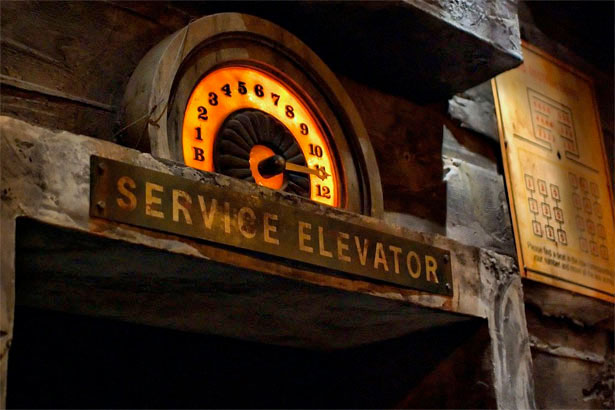
Realistically, elevator pitches should be even better than the above. Furthermore, they can be used as an introduction to a portfolio, or used on the about page to help make sales there, too. To find out more about elevator pitches and how to write the perfect pitch, check out the resources below.
Further Resources
- Is Your Elevator Pitch a Home Run?
- The Writer’s Elevator Pitch
- Not Getting a Rise out of your Elevator Speech?
- Write an Elevator Pitch for Your Blog
- Elevator Pitch 101 – Intro To Writing a 30 Second Elevator Pitch
7. Write an About Page
Your about page is where clients and others who may want to work with you can get to know you, before having to make any sort of contact. It should reflect yourself, and the way you do business.
Is your brand fun, professional or to-the-point? Most likely, your brand so far has reflected your personality in its own sense already. It's now up to you to write an about page that can "make the sale".
If a person has become interested enough to check out the about page, you have somehow convinced them to become at least half-way interested in your services.
Hopefully, you've attracted the right person based from your declared target audience. If so, how would you talk to this person?
Content-wise, you're going to want to keep to your original style. For example, if you want a more company-like approach, write more formally. For a more creative approach, be personable and fun.
Your career choice as a freelancer and the work you do probably already reflects your personality a great deal, so just being yourself is the best option when trying to find a writing style for the about page.
It is of utmost importance to not try to sound like anyone else — your own voice is what makes you different from every other freelancer on the planet.
After figuring in the writing style and how to approach the page, one must outline what to include. Below is a minimum:
- Your history in the field and what you do.
- Your professional experience, and possibly school experience if present.
(A written résumé) - Perhaps a link to a more formal resume.
- Contact information, or a link to the contact page.
- A relevant note to their problem, and how you can help them.
(They need a website, you can make one for them.)
One may want to include other sections that further define their personality and business.
The more a potential client feels they know you, the more likely they'll be to make contact because you and your business will seem more approachable. (Keep in mind though that it need not be a 10 page autobiography!)
Further Resources
- Your About Page Is a Robot
- How to Write Your "About Me" Page
- The 4 Essential Elements of an About Me Page
- Best Practices For Effective Design Of "About me"-Pages
- Five Tips (and a Bonus!) on How to Write a Fantastic About Page
- The Importance Of An "About Me" Page
8. Get Clients to Reach You
Now that you have a brand, it's all about marketing and having clients find you.
You've created a target audience, identified business goals (both present and future goals), built the brand in a design sense around those two definition, and created content that helps sell your material.
This is all great, but at this point your brand is unknown and inactive. Don't worry though — your brand is supposed to do the work for you, and given the time, it will.
Let people know about your brand by getting listed on job websites, doing guest posts, or leaving messages in forums. Generally, marketing is the same — but now you must market your brand as opposed to yourself.
Keeping Consistent
In my own experiences with branding, I've found myself re-branding and trying out new things.
It all came down to the fact that I had never taken the time to correctly brand my business, and specifically, that I had never taken the time to find my true target audience.
That forced me to revamp my brand to meet my needs as time went on. I could have avoided the whole mess if I would have taken the time in the beginning.
In the end, that has hurt my business because clients, readers, and other people that keep my business alive didn't recognize me and my business after each revamp, and it also hurt my credibility.
It is essential to keep a brand consistent, for the reasons mentioned above, and for a number of other reasons. Once you lose the brand, you lose all of the benefits that come along with it. If you change a brand, even if it is being changes to better match goals today, it will have to start marketing from base zero once again.
Here are a few articles and tips on how to keep a brand consistent.
- Keeping Your Brand Consistent
- Is your online brand consistent?
- Keep Things Consistent - Basic Brand Management
Updating a Brand
As we change as professionals and as people, there is no doubt that we will want to change our brand too. We may grow into a design firm rather than a freelance web designer, or a web developer more so than a designer.
Much of the time a person will be focusing on one area of web work, only to find over time that their skill set and interests have expanded into something completely different.
- That's fine; that's life — we live, we grow, we change.
- The trick now is to not change your brand, but to upgrade it, and develop it further.
This is where our initial goals step into place. With the correct planning of our goals in the first place, we were able to plan ahead for moving forward. Perhaps you were a single, lonely freelancer back in the day you created your brand, but now you've finally got a team together as a firm, just as one of your goals stated. If you planned the brand around that goal successfully, you may only need to make a few tweaks, while still making your brand recognizable and overall, the same. - To upgrade a brand, keep a few things consistent: the name, the style, and the main color combination.
The name is the most recognizable part of a brand, so that is something you will never want to change. The overall style is very tightly knit into your target audience, and in order to keep your current client base, you'll want to keep that. Lastly, color is one of the most memorable aspects visually, and most likely is the driving force visual for your brand. Keep this, and you keep the tone and memorable factor of your brand.
Further Resources
- How to Get Clients to Come to You
- 8 Brilliant Freelance Job Boards to Help You Get More Clients
- Getting the Freelance Gigs to Come to You — Your Resume and Portfolio
Wrapping Up
Brand creation is definitely an art in itself, and takes a lot of time to plan.
Don't rush through this essential step of a freelancing career — having a brand can not only benefit you as a web professional, but also avoid fallbacks and can aid as a form of security.
No matter how big your business is — how big your client base, your team, or your popularity is — develop a plan, a brand around it if you haven't already.
Then, stick to it, be consistent. It may also be helpful to take a step back if you already have a brand to analyze it. Can it be upgraded or further developed? Are you missing anything essential to your brand thus far?
There are, of course, many more tips and suggestion that could be mentioned, and much of it is a matter of personal experiences.
Written exclusively for WDD by Kayla Knight.
Please share any further tips or experiences you've had with branding as a freelancer. What have you learned from your own mistakes?


